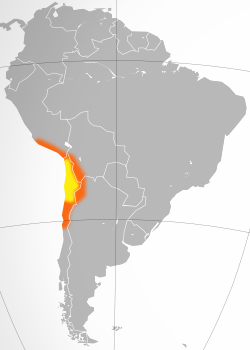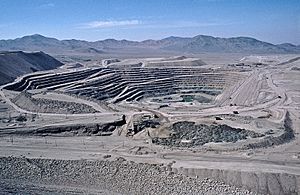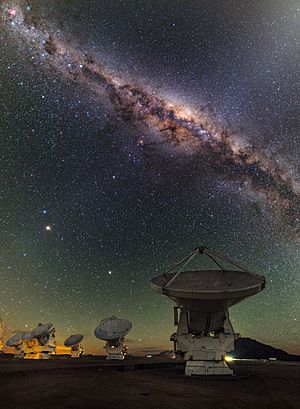Atacama Desert facts for kids
Quick facts for kids Atacama Desert |
|
|---|---|

Atacama by NASA World Wind
|
|

Map of the Atacama Desert: the area most commonly defined as Atacama is in yellow. In orange are the outlying arid areas of the southern Chala, Altiplano, Puna de Atacama, and Norte Chico. The vertical extent of the satellite photo is approximately 2,600 km, encompassing the desert and surrounding regions.
|
|
| Ecology | |
| Realm | Neotropical |
| Biome | Deserts and xeric shrublands |
| Borders | Central Andean dry puna, Chilean matorral, and Sechura Desert |
| Geography | |
| Area | 104,741 km2 (40,441 sq mi) |
| Country | Chile |
| Coordinates | 24°30′S 69°15′W / 24.500°S 69.250°W |
| Conservation | |
| Protected | 3,385 km² (3%) |

The Atacama Desert (Spanish: Desierto de Atacama) is a huge desert located along the Pacific coast of South America. You can find it in the northern part of Chile. It stretches for about 1,600 kilometers (1,000 miles) west of the Andes Mountains.
This desert covers an area of about 105,000 square kilometers (40,500 square miles). If you include the dry lower slopes of the Andes, it grows to 128,000 square kilometers (49,400 square miles).
The Atacama Desert is the driest nonpolar desert on Earth. It's even drier than some polar deserts! It's also the largest fog desert in the world. Because it looks so much like Mars, scientists have used it to test equipment for Mars missions.
The desert stays super dry because of two main things. First, a cool ocean current called the Humboldt Current flows nearby. Second, strong winds from the Pacific Ocean also play a role. These conditions create a "rain shadow" effect. This means the Andes Mountains block moisture from the east, and the Chilean Coast Range blocks moisture from the west. So, very little rain can reach the desert.
Contents
What's the Weather Like in the Atacama Desert?

The Atacama Desert is famous for being the driest place in the world. On average, it gets only about 15 millimeters (0.6 inches) of rain each year. Some records even suggest that parts of the Atacama might not have had any important rainfall for over 400 years, from 1570 to 1971!
Scientists believe the Atacama might be the oldest desert on Earth. It has been extremely dry for at least the last 10 to 15 million years.
Because it's so dry, many mountains in the Atacama that are taller than 6,000 meters (20,000 feet) have no glaciers. Only the very highest peaks, like Ojos del Salado, have some snow all year round.
In one area about 100 kilometers (60 miles) south of Antofagasta, the soil looks a lot like the soil on Mars. Because of this, the Atacama has been used as a filming location for movies and TV shows about Mars. For example, the 2004 TV series Space Odyssey: Voyage to the Planets filmed scenes here.
Plants of the Atacama Desert

Even though the Atacama Desert is very dry, many different kinds of plants grow there. Over 500 species have been found in this desert. These plants are amazing because they have learned to live in such a tough environment.
Common plants include herbs and flowers like thyme and saltgrass. In places where there is a bit more moisture, you can find trees like the chañar and algarrobo.

One special plant is the llareta. It's one of the highest-growing wood species in the world, found at altitudes between 3,000 and 5,000 meters (10,000 to 16,000 feet). It grows in a dense, pillow-like shape that can be 3 to 4 meters (10 to 13 feet) thick. This shape helps it collect and keep heat from the sun to survive the cold nights. Llaretas grow very slowly, about 1.5 centimeters (0.6 inches) per year. This means many llareta plants are over 3,000 years old!
The desert also has many types of cacti and other plants that love dry weather. Some cacti, like the candelabro, can grow up to 7 meters (23 feet) tall.
Sometimes, after enough rain, a special event called the "flowering desert" (Spanish: desierto florido) happens. This is when the southern Atacama Desert bursts into colorful blooms from September to November. It's a beautiful sight!
Animals of the Atacama Desert

The extreme dryness of the Atacama Desert means that only a few animals can live there all the time. Some parts are so dry that nothing can survive. But in other areas, you can find interesting creatures.
- Insects: Sand-colored grasshoppers blend in with the ground. Beetles and their larvae are an important food source in the lomas (foggy hills). Desert wasps and butterflies appear during warmer, humid times. Red scorpions also live here.
- Reptiles and Amphibians: Surprisingly few reptiles and amphibians live in the desert. The Vallenar toad lives on the lomas, laying its eggs in ponds. Lizards like Liolaemus species live in dry areas near the ocean. One type, Liolaemus fabiani, is only found in the Salar de Atacama (Atacama salt flat).
- Birds: Birds are one of the most diverse animal groups. Humboldt penguins live along the coast all year. Inland, high-altitude salt flats are home to Andean flamingos, while Chilean flamingos can be seen by the coast. Other birds, like hummingbirds, visit the lomas to find food. The lomas help protect rare birds like the endangered Chilean woodstar.
- Mammals: Only a few mammals are specially adapted to the Atacama's extreme dryness. These include Darwin's leaf-eared mouse. In less dry areas, you might see the South American gray fox and the viscacha (a relative of the chinchilla). Larger animals like guanacos and vicuñas eat grass in areas that get water from melted snow. South American fur seals and South American sea lions often gather along the coast.
People Living in the Atacama Desert

The Atacama Desert doesn't have many people living in it. Most towns are found along the Pacific coast. However, some oases and valleys in the interior have been home to people for thousands of years. These areas were where some of the most advanced ancient societies in Chile lived.
In the past, a large flat area called Pampa del Tamarugal was a woodland. But in the 18th and 19th centuries, people cut down many trees for firewood to use in silver and saltpeter mining. This caused widespread deforestation.
Amazing Astronomical Observatories
The Atacama Desert is one of the best places in the world to look at the stars! This is because it has:
- High altitude (it's very high up)
- Almost no clouds
- Very dry air
- No light pollution from big cities
- No radio interference
Because of these perfect conditions, you can see hundreds of thousands of stars with a telescope. The desert has more than 200 clear, cloudless nights every year. Many telescopes have been built here to help astronomers from all over the world study the universe.
One of the biggest telescopes is the Atacama Large Millimeter Array (ALMA). It's a huge radio astronomy telescope built by many countries, including Europe, Japan, the United States, Canada, and Chile. It officially opened in 2011. Other radio telescopes have been working in the area since 1999.
The European Southern Observatory (ESO) runs three major observatories in the Atacama:
- La Silla Observatory
- Paranal Observatory, which has the Very Large Telescope (VLT)
- Llano de Chajnantor Observatory, home to ALMA
ESO is also building a fourth site, Cerro Armazones, which will be home to the future Extremely Large Telescope (ELT).
Other Fun Uses of the Atacama Desert
Sports in the Desert
The Atacama Desert is a popular spot for off-road sports. Many races have taken place here, including parts of the famous Dakar Rally. The desert's sand dunes near the city of Copiapó are perfect for rally races. People also enjoy sandboarding on the dunes.
There's even a week-long foot race called the Atacama Crossing, where competitors run across the desert's different landscapes. Another event, the Volcano Marathon, happens near the Lascar volcano.
Tourism in the Atacama
Most visitors who come to explore the desert stay in the town of San Pedro de Atacama. The Atacama Desert is one of the top three tourist destinations in Chile. There's even a special hotel just for astronomers and scientists who work at the observatories.
Images for kids
-
A flat area of the Atacama Desert between Antofagasta and Taltal
-
Salt evaporation ponds in the Atacama Desert
-
Desert bloom (desierto florido)
-
Liolaemus nitidus, a lizard native to the southern reaches of the Atacama Desert
Protected areas
- Pan de Azúcar National Park
- Pampa del Tamarugal National Reserve
- La Chimba National Reserve
Legends
- Alicanto
- Atacama Giant
See also
 In Spanish: Desierto de Atacama para niños
In Spanish: Desierto de Atacama para niños
- Camanchaca
- List of deserts by area
- Lomas
- Llano de Chajnantor Observatory
- Mano del Desierto
- Norte Grande
- Paposo
- Pulperia
- Puna de Atacama
- Salar de Atacama
- Transverse Valleys
- The asteroid 18725 Atacama has been named after the Atacama Desert.
- Lençóis Maranhenses National Park























